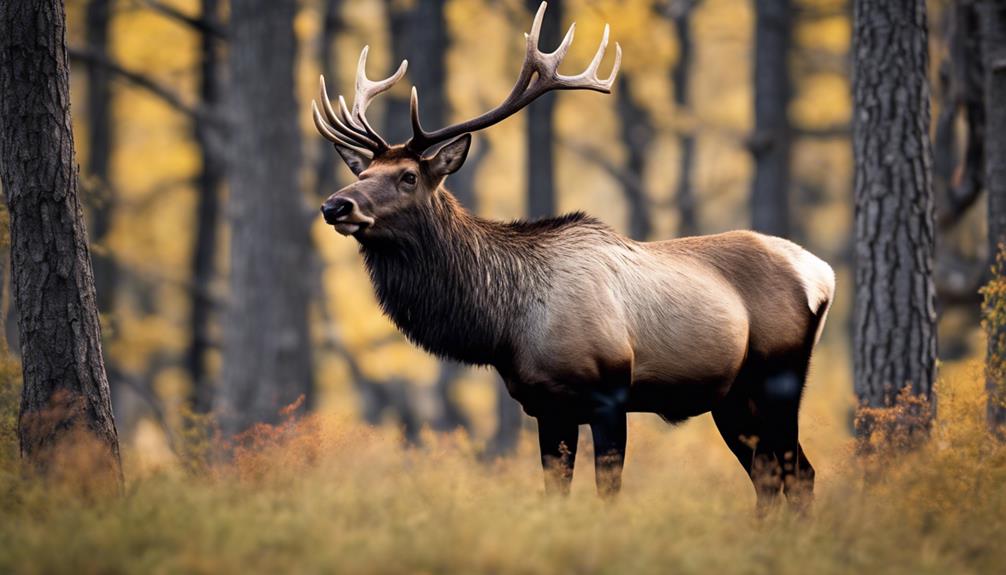Are you ready to embark on a journey through the intricate world of North America’s elk subspecies, like unraveling a tapestry of nature’s diversity?
Discover the intricate web that connects these majestic creatures to their habitats and the challenges they face in a changing environment. Each subspecies holds a unique place in the tapestry of North America’s wildlife, with tales of survival, resilience, and adaptation waiting to be unveiled.
As you delve deeper into the realm of elk subspecies, you will uncover a world where conservation efforts and natural history intertwine, offering a glimpse into the delicate balance of ecosystems and the enduring spirit of these iconic animals.
Elk Population and Range
Elk populations in North America, spanning the continental United States and Canada, remain stable and widespread. These majestic creatures can also be found on Afognak, Raspberry, Etolin, and Zarembo islands off the coast of Alaska.
Interestingly, elk showcase adaptability by thriving in non-native habitats like Argentina and New Zealand. While the concentration of elk populations is higher in the United States, significant numbers also roam the vast lands of Canada.
It’s fascinating to note that elk populations have managed to establish themselves in diverse environments, showcasing their resilience and ability to thrive in various landscapes. Their presence not only enriches the ecosystems they inhabit but also offers a glimpse into the adaptability and strength of these magnificent creatures. Whether wandering the forests of the United States or the wilderness of Canada, elk continue to captivate with their grace and grandeur.
Elk Subspecies Overview
Pivoting from the discussion of elk populations in North America, the diverse elk subspecies present a fascinating array of characteristics and distinctions. Among the surviving subspecies are the Roosevelt elk, Tule elk, Rocky Mountain elk, and Manitoban elk.
The Roosevelt elk, named after Presidents Theodore and Franklin Roosevelt, stands out as the largest of the surviving subspecies. On the other hand, the Rocky Mountain elk and Roosevelt elk boast the largest body mass.
In contrast, the Tule elk holds the title for being the smallest among the elk subspecies. The Manitoban elk, the last of the surviving subspecies, is nearly as large as the Rocky Mountains elk, characterized by its short antlers.
These elk subspecies each bring unique traits to the table, contributing to the rich tapestry of North American wildlife.
Specific Characteristics of Surviving Elk Subspecies
Among the surviving elk subspecies in North America, each subspecies possesses distinct characteristics that contribute to the biodiversity of the region.
The Roosevelt elk, named after Presidents Theodore and Franklin Roosevelt, is the largest of the four surviving elk subspecies. These migratory animals move from mountains to lowlands.
Rocky Mountain elk, one of the largest subspecies, prefer upland forests in mountainous regions, with an estimated population of around 1 million individuals.
Tule elk, found in California, is the smallest of the elk subspecies, with a population of approximately 4000 individuals, now increased to around 5700 due to conservation efforts.
The Manitoban elk, the last of the surviving subspecies, is almost as large as the Rocky Mountain elk and has short antlers. Each of these elk subspecies plays a crucial role in the ecosystem, showcasing unique characteristics that make them essential to the North American wildlife landscape.
Range and Conservation Efforts
Moving on from the specific characteristics of the surviving elk subspecies, let’s now focus on the range and conservation efforts related to these majestic animals in North America.
The Manitoban Elk, found in North Dakota, northeastern Montana, Manitoba, Alberta, and Saskatchewan, faced near-extinction in the late 1800s but has since rebounded to about 6500 individuals in the wild. This subspecies, almost as large as the Rocky Mountain elk, boasts short antlers and inhabits a broad range across these regions.
Unfortunately, the Eastern Elk, one of the two extinct elk subspecies, met its demise in 1877 in Pennsylvania due to overhunting and habitat loss. The Merriams Elk, another extinct subspecies, vanished in the late 19th century, primarily occupying arid southwestern states like Arizona and New Mexico. Conservation efforts continue to play a crucial role in preserving the remaining elk subspecies and ensuring their populations thrive in their natural habitats.
General Elk Information
As we delve into the realm of elk knowledge, it’s essential to understand that elk are among the largest wild herbivores, spanning habitats from North America to Eurasia. They’re majestic creatures known for their impressive antlers and large size. Elk populations in North America are stable, with significant numbers found in the United States and Canada. The adaptability of elk is evident in their presence in non-native habitats like Argentina and New Zealand.
Among the surviving elk subspecies in North America are the Roosevelt elk, Tule elk, Rocky Mountain elk, and Manitoban elk. Each subspecies has unique characteristics, with the Roosevelt elk being the largest and the Tule elk being the smallest. Conservation efforts have helped increase the populations of Tule and Manitoban elk in recent years.

Erzsebet Frey (Eli Frey) is an ecologist and online entrepreneur with a Master of Science in Ecology from the University of Belgrade. Originally from Serbia, she has lived in Sri Lanka since 2017. Eli has worked internationally in countries like Oman, Brazil, Germany, and Sri Lanka. In 2018, she expanded into SEO and blogging, completing courses from UC Davis and Edinburgh. Eli has founded multiple websites focused on biology, ecology, environmental science, sustainable and simple living, and outdoor activities. She enjoys creating nature and simple living videos on YouTube and participates in speleology, diving, and hiking.
- WILDLIFE THEMED T-SHIRTS
Cute Hedgehog Embroidered: Love Wildlife, Protect Nature Wildlife conservation tees
$35.00







